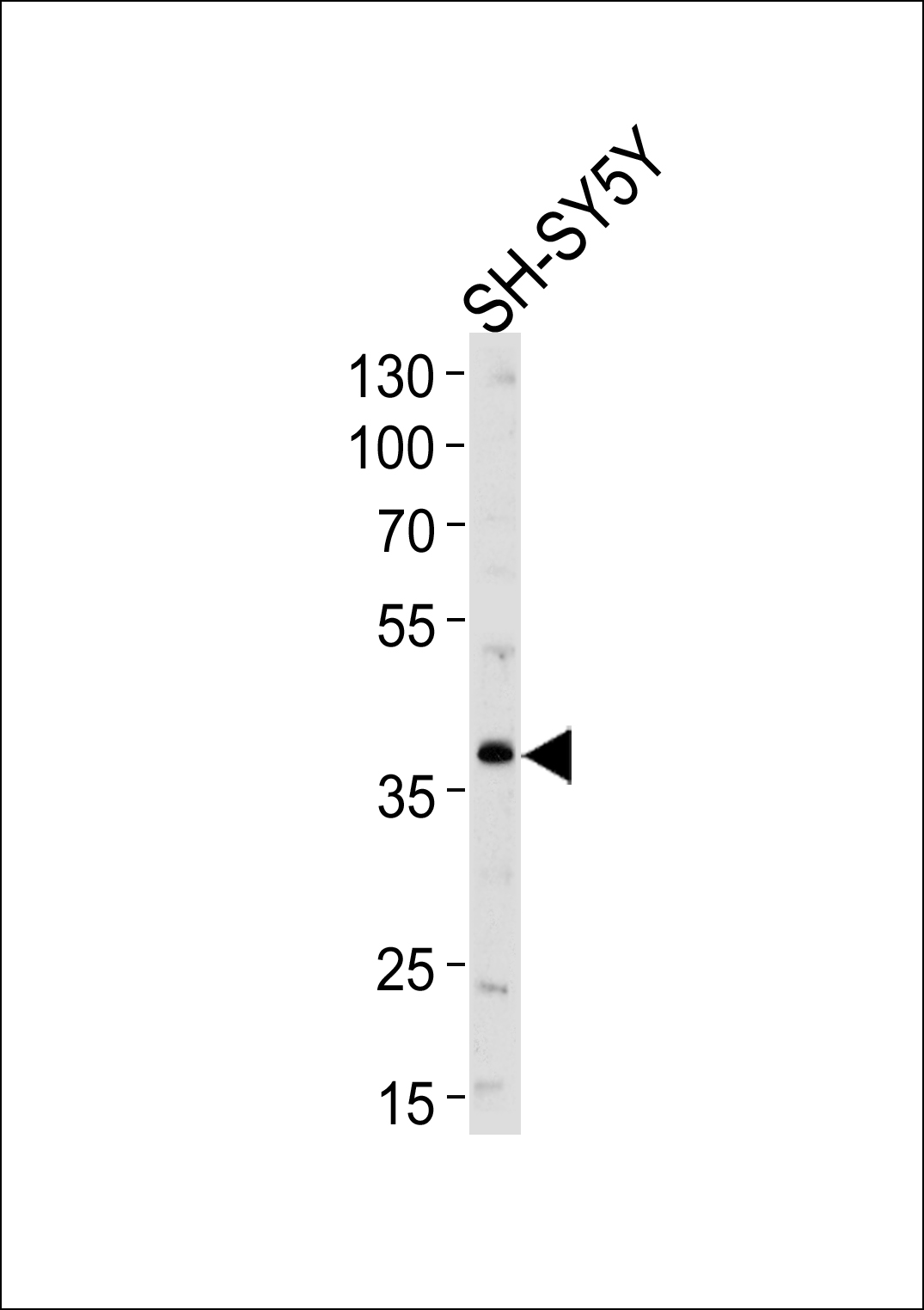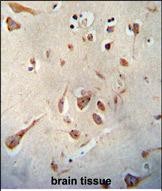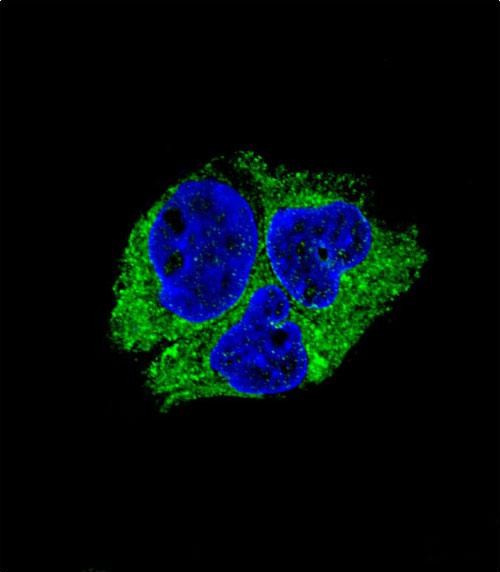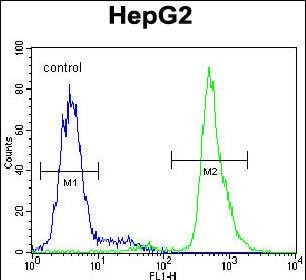SERPINI1 Antibody (N-term)
Affinity Purified Rabbit Polyclonal Antibody (Pab)
- 产品详情
- 实验流程
- 背景知识
Application
| IHC-P, IF, FC, WB, E |
|---|---|
| Primary Accession | Q99574 |
| Other Accession | NP_001116224.1 |
| Reactivity | Human |
| Host | Rabbit |
| Clonality | Polyclonal |
| Isotype | Rabbit IgG |
| Calculated MW | 46427 Da |
| Antigen Region | 19-45 aa |
| Gene ID | 5274 |
|---|---|
| Other Names | Neuroserpin, Peptidase inhibitor 12, PI-12, Serpin I1, SERPINI1, PI12 |
| Target/Specificity | This SERPINI1 antibody is generated from rabbits immunized with a KLH conjugated synthetic peptide between 19-45 amino acids from the N-terminal region of human SERPINI1. |
| Dilution | IHC-P~~1:100~500 IF~~1:10~50 FC~~1:10~50 WB~~1:1000 E~~Use at an assay dependent concentration. |
| Format | Purified polyclonal antibody supplied in PBS with 0.09% (W/V) sodium azide. This antibody is purified through a protein A column, followed by peptide affinity purification. |
| Storage | Maintain refrigerated at 2-8°C for up to 2 weeks. For long term storage store at -20°C in small aliquots to prevent freeze-thaw cycles. |
| Precautions | SERPINI1 Antibody (N-term) is for research use only and not for use in diagnostic or therapeutic procedures. |
| Name | SERPINI1 |
|---|---|
| Synonyms | PI12 |
| Function | Serine protease inhibitor that inhibits plasminogen activators and plasmin but not thrombin (PubMed:11880376, PubMed:19265707, PubMed:19285087, PubMed:26329378, PubMed:9442076). May be involved in the formation or reorganization of synaptic connections as well as for synaptic plasticity in the adult nervous system. May protect neurons from cell damage by tissue-type plasminogen activator (Probable). |
| Cellular Location | Secreted. Cytoplasmic vesicle, secretory vesicle lumen. Perikaryon |
| Tissue Location | Detected in brain cortex and hippocampus pyramidal neurons (at protein level) (PubMed:17040209). Detected in cerebrospinal fluid (at protein level) (PubMed:25326458). Predominantly expressed in the brain (PubMed:9070919). |
For Research Use Only. Not For Use In Diagnostic Procedures.
Provided below are standard protocols that you may find useful for product applications.
BACKGROUND
This gene encodes a member of the serpin superfamily of serine proteinase inhibitors. The protein is primarily secreted by axons in the brain, and preferentially reacts with and inhibits tissue-type plasminogen activator. It is thought to play a role in the regulation of axonal growth and the development of synaptic plasticity. Mutations in this gene result in familial encephalopathy with neuroserpin inclusion bodies (FENIB), which is a dominantly inherited form of familial encephalopathy and epilepsy characterized by the accumulation of mutant neuroserpin polymers. Multiple alternatively spliced variants, encoding the same protein, have been identified.
REFERENCES
Takehara, S., et al. J. Mol. Biol. 403(5):751-762(2010)
Han, S., et al. Hum. Immunol. 71(7):727-730(2010)
Rajaraman, P., et al. Cancer Epidemiol. Biomarkers Prev. 19(5):1356-1361(2010)
Davies, M.J., et al. J. Biol. Chem. 284(27):18202-18209(2009)
Rajaraman, P., et al. Cancer Epidemiol. Biomarkers Prev. 18(5):1651-1658(2009)
终于等到您。ABCEPTA(百远生物)抗体产品。
点击下方“我要评价 ”按钮提交您的反馈信息,您的反馈和评价是我们最宝贵的财富之一,
我们将在1-3个工作日内处理您的反馈信息。
如有疑问,联系:0512-88856768 tech-china@abcepta.com.























 癌症的基本特征包括细胞增殖、血管生成、迁移、凋亡逃避机制和细胞永生等。找到癌症发生过程中这些通路的关键标记物和对应的抗体用于检测至关重要。
癌症的基本特征包括细胞增殖、血管生成、迁移、凋亡逃避机制和细胞永生等。找到癌症发生过程中这些通路的关键标记物和对应的抗体用于检测至关重要。 为您推荐一个泛素化位点预测神器——泛素化分析工具,可以为您的蛋白的泛素化位点作出预测和评分。
为您推荐一个泛素化位点预测神器——泛素化分析工具,可以为您的蛋白的泛素化位点作出预测和评分。 细胞自噬受体图形绘图工具为你的蛋白的细胞受体结合位点作出预测和评分,识别结合到自噬通路中的蛋白是非常重要的,便于让我们理解自噬在正常生理、病理过程中的作用,如发育、细胞分化、神经退化性疾病、压力条件下、感染和癌症。
细胞自噬受体图形绘图工具为你的蛋白的细胞受体结合位点作出预测和评分,识别结合到自噬通路中的蛋白是非常重要的,便于让我们理解自噬在正常生理、病理过程中的作用,如发育、细胞分化、神经退化性疾病、压力条件下、感染和癌症。









